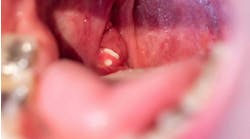An estimated 9 million persons work in the health care profession in the U.S., including approximately 168,000 dentists, 112,000 registered dental hygienists, 218,000 dental assistants and 53,000 dental laboratory technicians. This does not include students and other trainees.
The CDC and OSHA have issued regulations designed to prevent and reduce the potential for disease transmission from patient to dental health care professional (DHCP), DHCP to patient, and patient to patient. Although these tenets focus primarily on outpatient dental health care settings, they are applicable to all settings in which dental treatment is provided.
Dental patients and DHCP can be exposed to pathogenic microorganisms, including cytomegalovirus, hepatitis B and C, herpes simplex virus types 1 and 2, the human immunodeficiency virus, Mycobacterium tuberculosis, staphylococci, streptococci, and other viruses and bacteria that infect the oral cavity and respiratory tract. These organisms can be transmitted in dental settings through 1) direct contact with blood, oral fluids, or other patient materials, 2) indirect contact with contaminated objects such as instruments and equipment, 3) contact of conjunctival, nasal, or oral mucosa with droplets containing microorganisms generated from an infected person and propelled through coughing, sneezing, or talking, and 4) inhalation of airborne microorganisms that can remain in the air for long periods.
Infection through any of these requires all of the following conditions:
• a pathogenic organism of sufficient virulence and in adequate numbers to cause disease
• a reservoir or source, such as blood, that allows the pathogen to survive and multiply
• a mode of transmission from the source to the host
• a portal of entry through which the pathogen can enter the host, and
• a susceptible host (i.e., one who is not immune).
Preventive practices used to reduce blood exposures, particularly percutaneous exposures, include 1) careful handling of sharp instruments, 2) use of rubber dams to minimize blood spattering, 3) hand washing, and 4) use of protective barriers such as gloves, masks, eyewear, and gowns. Preventing exposure to bloodborne pathogens is called universal precautions.
In 1996, the concept was changed to standard precautions. These expand universal precautions into a standard of care designed to protect DHCP and their patients from pathogens that can be spread by blood or any other body fluid, excretion, or secretion. Standard precautions apply to contact with blood, nonintact skin, mucous membranes, and body fluids, secretions, and excretions except sweat, regardless of whether they contain blood.
Saliva has always been considered a potentially infectious material, so no operational difference exists between universal precautions and standard precautions. In addition to standard precautions, transmission-based precautions might be necessary to prevent the spread of certain diseases such as TB, influenza, and varicella that are transmitted through airborne, droplet, or contact transmission.
DHCP should be familiar with the controls that categorize and prioritize prevention strategies. For bloodborne pathogens, engineering controls that eliminate or isolate the hazard (puncture-resistant sharps containers or needle-retraction devices) are the primary strategies for protecting DHCP and patients. Where engineering controls are not appropriate, work-practice controls that result in safer behaviors, and use of personal protective equipment (PPE) such as eyewear, gloves, and masks can prevent exposure. In addition, administrative controls are a priority for certain pathogens (e.g., M. tuberculosis), particularly those spread by airborne or droplets.
The goal of this special issue of RDH is to provide background and practical information for dental hygienists. It addresses occupational risks and shares specific practices designed to reduce or eliminate the acquisition of infectious diseases during patient treatment. Products and procedures that provide protection will be discussed. In addition to the six articles, this special issue includes a list of Top Infection Control Resources and a continuing education exam.





